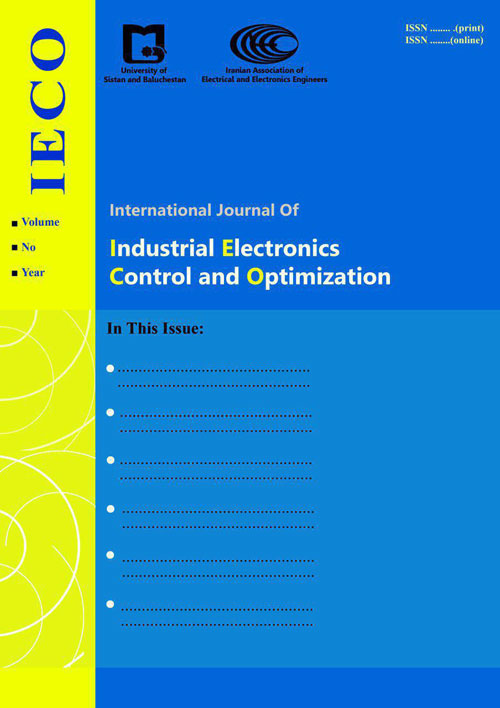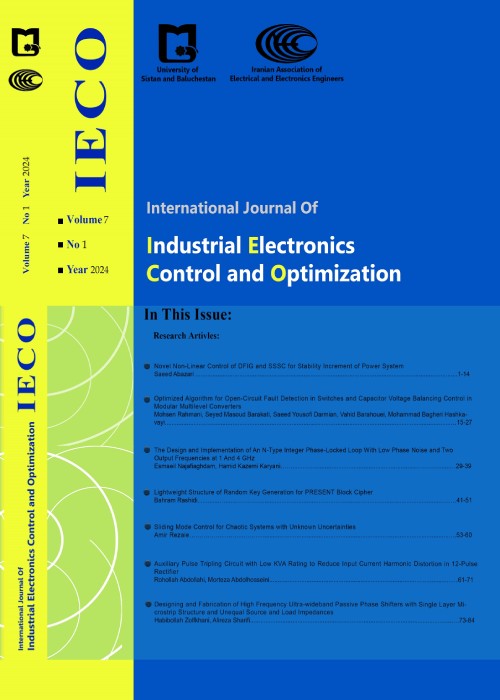فهرست مطالب

International Journal of Industrial Electronics, Control and Optimization
Volume:1 Issue: 1, Spring 2018
- تاریخ انتشار: 1397/03/14
- تعداد عناوین: 8
-
-
Pages 1-8For a two-input two-output distillation column with heavy interactions and long dead times, a two-by-two PI/PID controller is designed. The design objectives are good setpoint regulation and appropriate load disturbance rejection. The constraints are on degree of robust stability, control effort as well as peaks of the maximum singular value of sensitivity and complementary sensitivity matrices. As this set of design objectives and constraints is often conflicting, a more flexible control structure, a two-degree-of-freedom scheme, is proposed. The design problem is formulated as a constrained optimization problem and is solved by a powerful random-search optimization technique, the so-called vector-based swarm optimization. Next, the performance of the proposed method in controlling a Wood and Berry distillation column is evaluated and compared with that of several well-known design techniques. Because of using a flexible control structure, a powerful optimization algorithm and a comprehensive set of design requirements, the proposed control strategy performs well in coping with conflicting design objectivesKeywords: Load disturbance rejection, Robustness, Setpoint regulation, Two, degree, of, freedom control structure, Wood, Berry distillation column
-
Pages 9-18This paper develops a new possibilistic-scenario model for a wind power plant to determine its optimal self-scheduling (SS) in the presence of high-impact low-probability events uncertainty. Nowadays, in the context of the power system, examining the effects of extreme weather events in the category of high-impact low-probability (HILP) events has become one of the most important issues for researchers all around the world. There are so many reports of HILP events which acknowledge that these incidents can directly affect the power plants and cause them to fail. Generally, the self-scheduling of generating units in the pre-extreme weather conditions would be different from normal conditions. In such manners, this paper tries to address the self-scheduling problem of a wind power plant in pre-extreme weather conditions. For this purpose, there are numerous uncertainty sources in the SS problem that could affect the final results which include electricity prices, wind power production and contingency-based lack of production in the face of HILP events. In this regard, this paper proposes an efficient hybrid probabilistic-possibilistic assessment tool for dealing with these uncertainties. Additionally, CVaR evaluation was used as the intrinsic risk management tool of both probabilistic and possibilistic parameters in the SS problemKeywords: Electricity Market, High, impact low, probability (HILP) events, Risk management, Self, Scheduling, Wind power plant
-
Pages 19-26Energy storage systems, along with many capabilities in the grid, are costly technologies. Therefore, their economic issues should be also considered while they are used in the grid. In this paper, a method has been proposed that can be used to determine the location, power, and capacity of the energy storage systems with consideration of the technical and economic aspects, simultaneously. Technical goals of this method are improvement of voltage profile and loss reduction, while economic objectives are including reduction of investment cost, operation and maintenance cost of the energy storage system. The problem of optimization is solved with the symbiotic organisms search algorithm. The main advantage of this algorithm is the absence of specific regulatory parameters compared to other meta-heuristic algorithms. The proposed plan has been implemented safely. Safe performance is achieved by enforcing security constraints such as voltage and power balancing and constraints for the energy storage system, such as capacity of energy and power constraints, and amount of energy stored. The distributed generation used in this plan is wind power plant. The output of each turbine is determined by a linear model reliant on wind speed. The proposed method has been implemented on the IEEE 33 bus grid. The results demonstrate the efficiency and capability of the proposed methodKeywords: energy storage systems, improvement of voltage profile, loss reduction, symbiotic organisms search algorithm, Wind power plant
-
Pages 27-40The application of distributed generation resources and capacitor banks is increasing due to the distribution networks extension and also power demand growth. Determining the installation location and the capacity are two important and effective factors on the network power loss and the network performance improvement. If connected in the right place to the power network, distributed generation power plants and the capacitors have different effects such as loss reduction, voltage profile improvement, and network reliability augmentation. In this paper, in order to reduce the distribution system loss, simultaneous optimal placement of the distributed generation resources and capacitors in radial distribution systems is studied. Crow search algorithm is applied for this purpose. This algorithm works on this idea that the crows chase each other in order to find other crow's food hiding place. The simulation is done on IEEE-33 & IEEE-69 buses network in MATLAB software. The simulation results demonstrate the efficiency of crow search algorithm, comparing to other applied optimization algorithms, in the problem of simultaneous optimal placement of the distributed generation resources and capacitors in radial distribution systems to reduce loss and enhance voltage profileKeywords: crow search algorithm (CSA), placement, size, capacitor, distributed generation (DG), power loss
-
Pages 41-51Nowadays short-term voltage instability is a major threat for power system reliability and stability owing to the increasing proportion of renewable energy sources such as solar and wind power, induction motor loads, HVDC links and etc. The aim of this paper is to determine the optimal location and size of static VAR compensator (SVC) to counteract the short-term voltage instability. A multi-objective optimization problem (MOP) is defined to satisfy the two objective functions: 1) minimizing the whole investment cost 2) minimizing the undesirable behavior of transient voltage under multiple probable contingencies. Composite load model consisting of induction motor loads and other components is modeled accurately. Moreover, the system is considered with a high penetration of wind power. Severity and risk indices are proposed to measure the degree of transient voltage performances. Candidate buses for SVC deployment are determined based on trajectory sensitivity analysis. Genetic algorithm is employed to find optimal allocation of SVC. The effectiveness of proposed approach is verified on New England 39-bus systemKeywords: Dynamic VAR support, reactive power planning, Short, term voltage stability, FACTS devices, Wind farm
-
Pages 53-60Microgrid is defined as a controllable unit which consists of Distributed Generations (DG), loads, energy storages and control devices. Microgrid has two operation modes including grid connected mode and islanding mode. In grid connected mode, voltage and frequency of microgrid is controlled by main grid and DGs supply total or part of the loads. In the islanding mode, the microgrid is disconnected from main grid because of a fault or a preplanned switching in connecting line. In this mode, DGs should satisfy the power demand of sensitive loads in microgrid. Since the only generation units in an islanded microgrid are existing DG units which usually are from several types. Consequently besides feeding total loads, voltage and frequency of microgrid should be controlled by these DG units. Hence, the microgrid could supply high power quality and reliability to customers. This paper presents an optimization method to optimize the parameters of the Microgrid controller in islanding mode. The controller optimal parameters have been obtained by using the particle swarm optimization (PSO). This is done based on minimization of the error in the current and voltage controllers. Finally, simulation has been carried out to verify the effectiveness of the optimized controller. Stability analysis of the controller is verified using classical approachKeywords: Distributed Generation, Microgrid, Islanding, Droop Control, Power Sharing
-
Pages 61-70The Doubly-Fed Induction Generators (DFIG) based Wind Turbines (WT) are widely used in WTs connected to power systems. Traditionally the back-to-back converters are used in order to control the DFIG. In this paper, an Indirect Matrix Converter (IMC) is utilized. Compared with back-to-back converters, IMCs have numerous advantages such as: higher level of robustness, reliability, reduced size and weight due to the absence of bulky electrolytic capacitor. According to the recent grid codes it is required that wind turbines remain connected to the grid during grid faults. It means that the plant must be in operation and be able to tolerate the fault conditions. This feature is called Fault Ride-Through (FRT) capability of wind plants. To improve FRT capability of the wind turbine, in this paper an adaptive gain scheduling controller is proposed. The proposed method could increase the damping of fault currents and hence attribute more time to controller for reactive power injection. Therefore, the new FRT standards are satisfied. PSIM simulation results confirm the efficiency of the proposed methodKeywords: DFIG, FRT, Indirect matrix converter, Wind turbine
-
Pages 71-80This paper presents a new and improved Torque Sharing Function (TSF) to minimize torque ripple of Switched Reluctance Motor (SRM). This approach combined of three steps. At first step, Genetic Algorithm has been used to define the best Turn-on and Turn-off angel of phase current. At second step, a fuzzy logic controller system has been designed as a new TSF. Finally, at the last step, Particle Swarm Optimization (PSO) has been used to optimize Fuzzy membership function. The two main merits of this approach are that the proposed control algorithm can be used in wide speed ranges and also three-step-design and optimization makes this approach enable to perfectly results in smooth torque. The effectiveness of this approach has been verified through a simulation of four phase 8/6 SRM in Matlab/Simulink. Obtained result from simulation shown that the produced torque was high quality and its ripple was one-third of fuzzy TSF. This proposed method is very powerful to adapt itself for various kind of SRMs with different parametersKeywords: SRM, Torque Sharing Function, ripple minimization, fuzzy interface System


